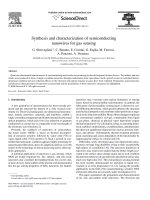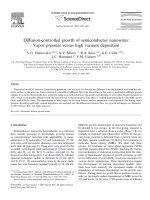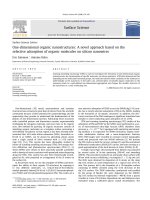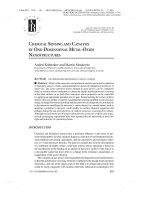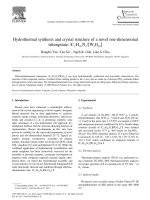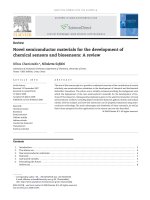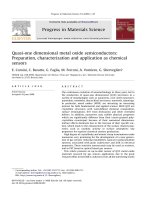- Trang chủ >>
- Khoa Học Tự Nhiên >>
- Vật lý
Semiconductor nanowires for novel one dimensional devices
Bạn đang xem bản rút gọn của tài liệu. Xem và tải ngay bản đầy đủ của tài liệu tại đây (584.82 KB, 8 trang )
Available online at www.sciencedirect.com
Physica E 21 (2004) 560 – 567
www.elsevier.com/locate/physe
Semiconductor nanowires for novel one-dimensional devices
L. Samuelson
a;∗
, M.T. Bjork
a
, K. Deppert
a
, M. Larsson
b
, B.J. Ohlsson
c
, N. Panev
a
,
A.I. Persson
a
,N.Skold
a
, C. Thelander
a
, L.R. Wallenberg
b
a
Solid State Physics, The Nanometer Structure Consortium, Lund University, Box 118, Lund S-221 00, Sweden
b
Materials Chemistry/the Nanometer Consortium, Lund University, Box 124, Lund S-221 00, Sweden
c
QuMat Technologies AB, Lund, Sweden
Abstract
Low-dimensional semiconductors oer interesting physical phenomena but also the possibility to realize novel types of
devices based on, for instance, 1D structures. By using traditional top-down fabrication methods the performance of devices is
often limited by the quality of the processed device structures. In many cases damage makes ultra-small devices unusable. In
this work we present a recently developed method for bottom-up fabrication of epitaxially nucleated semiconductor nanowires
based on metallic nanoparticle-induced formation of self-assembled nanowires. Further development of the vapor–liquid–
solid growth method have made it possible to control not only the dimension and position of nanowires but also to control
heterostructures formed inside the nanowires. Based on these techniques we have realized a series of transport devices such
as resonant tunneling and single-electron transistors but also optically active single quantum dots positioned inside nanowires
displaying sharp emission characteristics due to excitons.
? 2003 Elsevier B.V. All rights reserved.
PACS: 81.07.Vb; 73.40.Kp; 78.67.Hc; 73.40.Gk; 73.23.Hk
Keywords: Nanowire; Heterostructure; Quantum dot; Resonant tunneling; Coulomb blockade
1. Top-down vs. bottom-up fabrication methods
Quantum device structures are traditionally created
via lithographic techniques, i.e. by advanced pattern-
ing accompanied by some type of structuring, like
etching. This approach has a number of problems,
such as damage induced by the processing, often
resulting in dead layers and limited performance of
the resulting devices. An example is quantum wells
(QWs) formed in a planar growth mode, later followed
by patterning of the surface by wire or dot features,
∗
Corresponding author. Tel.: +46-46-222-7679; fax:
+46-46-222-3637.
E-mail address: (L. Samuelson).
features which are then transferred to the QW via an
anisotropic etch. Another well-known example is the
corresponding fabrication of 1D resonant tunneling
devices, again via the initial epitaxial formation of a
double-barrier structure surrounding a QW, later fol-
lowed by etching a narrow mesa structure containing
the 1D–0D–1D tunneling device [1]. These top-down
fabrication techniques have had only limited success
due to process induced damage.
Dierent approaches to self-organization of quan-
tum structures via bottom-up methods have been
developed allowing ultra-small dimensions without
the use of the most extreme lithography methods
and often with almost perfect and defect-free device
properties. The formation of quantum dots (QDs) by
1386-9477/$ - see front matter ? 2003 Elsevier B.V. All rights reserved.
doi:10.1016/j.physe.2003.11.072
L. Samuelson et al. / Physica E 21 (2004) 560 – 567 561
strain-induced nucleation of ultra-small islands via
the Stranski–Krastanow growth mode [2] has led to
high-quality optical QD structures. Out of the many
approaches aiming at nanowire formation we men-
tion the use of preformed structures where selective
growth on certain crystalline facets leads to forma-
tion of sharp V-grooves [3]. The intersection of such
grooves oers a nucleation site for nanowires. This
and most other methods are however not able to form
heterostructures inside the nanowires.
2. Vapor–liquid–solid growth mode of nanowires
Already during the 1960s Wagner and others [4]
studied the formation of micrometer-sized whiskers
that could be formed from a catalytically active metal
particle positioned at a crystalline surface. Strong ef-
fort was put on the fabrication of silicon whiskers
formed via the interface between a gold particle and a
silicon substrate. The mechanism of this vapor–liquid–
solid (VLS) growth mode is traditionally described
as a formation of a eutectic alloy between Au and Si
and a controlled establishment of a supersaturation of
the melt, which induces a transformation from the liq-
uid alloy phase to a phase where the melt co-exists
with the solid Si. This process can be compared with
that of liquid-phase epitaxy used for growth of e.g.
GaP from a Ga metal that is kept supersaturated by
the addition of GaP powder. The supersaturation and
the continued growth of the epitaxial crystal is main-
tained via a gradual decrease of the temperature of the
melt.
In the beginning of the 1990s Hiruma and
co-workers [5] grew semiconductor whiskers at
nanometer dimensions and studied them for their pos-
sible use in electronics and photonics. The nanowires
(primarily GaAs and InAs) were nucleated from
gold nanoparticles created by heating an evaporated,
sub-monolayer thick, gold ÿlm. Among the achieve-
ments can be mentioned the successful formation
of pn-junctions [6] and the demonstration of injec-
tion luminescence from such nanowire light-emitting
diodes [7]. Starting in the late 1990s, the group of
Lieber at Harvard has demonstrated the potential for
growth of doped nanowires for electronics, photonics
and biosensor applications [8–10].
3. Formation of heterostructures in nanowires
Around 1996, Hiruma et al., reported the possibility
to switch the composition of III–V nanowires from
InAs to GaAs [11], and also made some rudimentary
analysis of the composition variations. The next step
in this ÿeld came 2 years ago when high-resolution
electron microscopy imaging revealed the composi-
tion and structural quality of the InAs/GaAs interface
[12]. Furthermore, we also reported the mapping of
the lattice constants of the two binary materials. These
studies proved the interfaces to be abrupt on an atomic
scale and free of defects. Later also the InAs/InP sys-
tem was shown to possess highly abrupt and perfect
interfaces [13–15]. In Fig. 1, the color-coded lattice
map of an InAs/InP superlattice wire is shown. Here
Fig. 1. Left-hand ÿgure shows a color-coded representation of the
origin of diraction spots from the two lattices of InAs (green) and
InP (red). The right-hand ÿgure shows a high-resolution electron
microscope image of the same structure from which one can
deduce that the multiple layer structure of alternating InAs and
InP segments are perfect from a crystalline point of view, are free
of strain within less than 10 nm from the interface, and have an
interface abruptness on the atomic level.
562 L. Samuelson et al. / Physica E 21 (2004) 560 – 567
the thinnest InP layer (red) is merely 1:5 nm thick.
The formation of such thin layers is due to the very
slow growth rates and low pressures of the chemical
beam epitaxy approach to nanowire growth. This sep-
arate study also included the demonstration of how the
nanowire geometry is able to absorb the lattice mis-
match and how the system relaxes within about 10 nm
from the heterointerface, which is a result of generic
value since it opens the possibility to combine dierent
materials without having to maintain lattice matching
as in regular epitaxy. At the same time reports came
on composition modulation in the SiGe system [16]
along a nanowire and transitions within a nanowire be-
tween GaAs and GaP [17], including the observation
of luminescence from segments of GaAs surrounded
by GaP material, however, without any detailed
analysis of the abruptness of the transition regions.
4. Properties of single barriers in nanowires
From knowledge of the band structure and band
alignment in bulk III–V materials one could predict
that the conduction band oset between InAs and InP
should be at least 0:5 eV, a number which is not known
since it is not possible to form interfaces between
the two materials on a macroscopic scale. In order to
Fig. 2. (a) Band diagram of a single barrier nanowire. (b) A comparison between the I –V characteristics of a homogeneous n-type InAs
nanowire and one with an 80 nm thick InP barrier inserted. Thermal activation of the current, (c), gives an activation energy of about
0:6 eV for the conduction band oset.
investigate the band alignment and the electronic prop-
erties of the InAs/InP interfaces we studied the trans-
port through InAs nanowires containing thick InP re-
gions (80 –100 nm), which function as barriers and
prevent transport. From analysis of the thermionic
emission of electrons over the InP barriers (Fig. 2), we
deduced a conduction band oset of about 600 meV
[14], a number indicating that this material system
could be highly interesting for heterostructure elec-
tronics and photonics. By varying the thickness of the
InP barrier the eective resistance can be varied from
the few k level for a barrier of zero thickness, via
tunnel controlled resistance in the range of 100s of k
up to M and for very thick barriers up to the G to
T level. A couple of examples are shown in Fig. 3.
5. 1D resonant tunneling devices
One of the most demanding devices to fabricate and
one that is very strongly based on quantum phenom-
ena, is the resonant tunneling diode. These heterostruc-
ture devices are, in the conventional form, made by
surrounding a thin QW by two tunnel barriers, and on
either side of these barriers a low-band gap material
acting as emitter and collector. The functionality is
based on the resonant alignment of occupied states
L. Samuelson et al. / Physica E 21 (2004) 560 – 567 563
Fig. 3. Illustration of the dynamical range that can be covered by
inserting InP segments of dierent thicknesses (80, 7, and 0 nm
blue, red, and green, respectively) into an InAs nanowire.
in the emitter relative to the quantized states in the
QW. Hence, transmission through the device is pos-
sible only for certain ranges of applied bias, giving
rise to sharp peaks in the current–voltage characteris-
tics and to regions of applied voltages having negative
dierential conductance. This phenomenon is also of
great value for the use of resonant tunneling devices
in oscillator circuits [18].
One of the holy grails of low-dimensional devices
has been to try to realize resonant tunneling devices
for lower dimensions, i.e. with the emitter and collec-
tor being 1D nanowires and the central region a QD,
so that the ÿltering element is fully discrete. One of the
ÿrst serious attempts to realize this, was the 1D–0D–
1D resonant tunneling device made by researchers at
Texas Instruments during the late 1980s. Fig. 4 shows
illustrations taken from their publications and shows
their top-down method for fabricating such devices
[1,19]. First, the GaAs/AlGaAs multi-layer structures
are grown, with the GaAs QW surrounded by two Al-
GaAs tunnel-barriers, in turn surrounded by GaAs as
3D emitter and collector regions. Then electron beam
lithography and dry etching is used to form freestand-
ing rods (wires) of dierent diameters. In the bottom
part of Fig. 4 the resulting I–V characteristic of the
thinnest nanowires that were found to be electrically
active after the processing (200 nm), can be seen. It
is quite clear that top-down fabrication methods are
not quite able to produce the device dimensions for
which quantization eects are very signiÿcant. Simi-
lar conclusions can be made from other more recent
attempts to fabricate RTDs via QDs [20].
Fig. 4. Illustrations taken from publications from Texas Instru-
ments from the late 1980s, where top-down methods were used
to fabricate ultra-narrow mesas containing double-barrier resonant
tunneling structures. The smallest dimensions for which the pro-
cessed devices were still operating were just on the boarder line of
dimensions for which any quantization eects could be resolved.
Obviously, there is a need for bottom-up and
low-damage methods to produce such advanced
heterostructure devices. In Fig. 5 is shown a
low-resolution transmission electron microscopy
(TEM) image of such double-barrier structures made
by chemical beam epitaxy (CBE) [21]. We have cho-
sen to work with InAs-based nanowires, meaning that
the emitter and collector regions are made of InAs,
as is the central QD, while the barriers are made of
564 L. Samuelson et al. / Physica E 21 (2004) 560 – 567
Fig. 5. Low-resolution TEM image of nanowires transferred from
the wafer and deposited on a TEM-grid. The dimensions of the
wires are 40 –50 nm in diameter, with the InP tunnel barriers about
5 nm thick and the height of the central QD about 15 nm.
InP (compare Figs. 1–3). We have primarily worked
with wire diameters between 40–60 nm and tunnel
barrier thicknesses of about 5 nm and the width of
the central QD of about 15 nm.
These types of nanowires are mechanically broken
o from the wafer where they were grown and trans-
ferred to a SiO
2
-terminated silicon wafer. Ohmic con-
tacts are formed to the nanowire via electron-beam
lithography, metal evaporation and lift-o techniques,
in a similar way as how the single-barrier devices were
made. In order to verify that the barriers are actually
in the proper positions relative to the contacts used in
the measurements, a selective etch was used that re-
moves InAs and leaves InP virtually intact. This leaves
a topographic image of the double barrier, which will
reveal if the contacts have been improperly placed
relative to the tunneling structure.
The current–voltage characteristics of the fabricated
devices showed an eective blocking of the current
for biases up to more than 50 mV. This blocking is
followed, in a symmetric manner, by a sharp peak
(in Fig. 6(c)) at about 80 mV with a full-width at
half-maximum of about 5 mV, which can be converted
into an energy sharpness of the transition of about
2 meV. The inset shows that these devices are robust
to charging and hysteresis eects, since the voltage
traces for upwards and downwards sweeps are virtu-
ally identical. At higher biases features are seen which
can be interpreted as tunneling into excited states.
In some samples, this characteristic feature in the
I–V curves is replaced by a doublet feature which,
Fig. 6. (a) Shows a TEM image of the DBRT-structure,
lined up with the energy band diagram for the emitter-barrier-
dot-barrier-collector structure. (b) The energy band structure in
the emitter and collector regions are those of a series of 1D
density-of-states curves, for each of the laterally quantized states
while the energy structure of the central QD is fully quantized as
expected for a 0D QD structure. (c) shows the current–voltage
characteristics of the devices, with a sharp peak for biases for
which the band of occupied states are lined up with the lowest
QD state. This peak is followed by a dip until the ÿrst excited
states is lined up with the emitter states.
L. Samuelson et al. / Physica E 21 (2004) 560 – 567 565
although not proven, may indicate a situation with the
position of the Fermi level such that more than one
injecting emitter state is being populated. No charging
eects are seen in these devices probably due to the
fact that tunneling out of the QD is so fast that no
electron accumulation in the QD takes place under
these experimental conditions.
6. 1D single-electron transistor devices
With the technologies described above for forma-
tion of single tunnel barriers and double barrier struc-
tures, the methods are available for the building of
ideal single-electron transistor (SET) devices, i.e. de-
vices in which predeÿned tunnel barriers surround
a central island with a capacitance suciently small
so that the energy required to add another electron
to the dot is large compared to the thermal energy,
k
B
T . Such cases have been extensively studied us-
ing for instance Al=Al
2
O
3
technology [22] or with the
use of nanoparticles with controlled tunnel barriers
[23]. More recently, carbon nanotubes (CNTs) have
been employed to make SET-type of devices, either
by utilizing defect-related tunnel barriers inside the
CNTs [24] or by using conducting CNTs as leads to
a nanoparticle acting as the central island [25]. In one
case, an InP nanowire was used as the SET island [26],
connected to the source and drain via high-resistance
contacts, in a way similar to how CNTs have been
used for SET devices. However, it is clear that the ten-
ability of the barriers of InP inside an InAs nanowire
is very promising to build designed SETs having pre-
dictable properties.
In Fig. 7, a qualitative comparison between a DBRT
and a DB-SET device is shown, comparing cases with
the same materials and dimensions but with the change
in the length of the central island from a size (for the
DBRT device) where quantization eects dominate
the energies of the island, to a large size of the island
for which the quantization is only very small but the
charging energies are large (for the DB-SET device).
In the SET-device, the charging energy, which can be
written as E
C
=e
2
=C, is dominated by the capacitances
of the barriers and is only weakly dependent on the
length of the island. Hence, for a suciently large
island the charging energy E
C
will totally dominate
over the quantization energies.
Fig. 7. Principles of how the resonant tunneling device can be
converted into a single-electron transistor using identical technol-
ogy but with the size of the island extended from about 15 nm up
to about 100 nm, such that the quantization energies are reduced
to almost zero while the charging energies are still large.
Fig. 8. Principle of the blockade and single-electron transfer
through the island in a single-electron transistor as function of
source–drain and gate biases.
The principles of how the transport of electrons
through the SET occurs as function of the applied
source–drain bias and the gate voltage is sketched
in Fig. 8, from which is seen the expected Coulomb
blockade situation for small values of the applied
source–drain bias. This ÿgure also illustrates how a
gate applied to the system can push the ladder of
states in the island for N; N + 1, etc. electrons down
(for positive gate voltages) such that more electrons
can be added to the island or current be transported
through these levels, one by one. Experimental data
[27] for the designed nanowire SET devices are pre-
sented in Fig. 9, which shows the current vs. source–
drain voltage characteristics for two settings of the
gate potential, one chosen such that the blockade is
maximum and one (nearest) minimum, in which the
blockade is perfectly lifted. This behavior, in itself,
566 L. Samuelson et al. / Physica E 21 (2004) 560 – 567
Fig. 9. (a) Current vs. source–drain voltage for the SET shown
in Fig. 7, displaying ideal Coulomb blockade as well as complete
lifting of the blockade controlled by the gate potential. (b) Periodic
gate oscillations.
is indicative of that an ideal single island has been
formed in the nanowire between two tunnel barriers.
In Fig. 9(b) it is seen how the single-electron tunnel-
ing is perfectly periodic in gate voltage, a phenomenon
that can be followed and controlled for more than 50
electrons being added to or removed from the central
island.
7. Optically active QDs inside nanowires
One of the great challenges in the use of nanos-
tructures is the possibility to use a single QD as an
ideal photonic quantum emitter. If a single QD can be
addressed in such a fashion that it can be controllably
excited by a single exciton, it may be employed as a
single-photon-on-demand source [28], which would
be highly interesting for quantum optics in general
and for quantum cryptography in particular. High op-
tical quality and well deÿned and spectroscopically
Fig. 10. Photoluminescence spectra from a single GaInAs QD
positioned inside a GaAs nanowire shown as function of the
excitation intensity. For the lowest excitation intensities, a single
sharp line is seen, believed to be due to the single exciton. For
higher excitation intensities new excitonic features appear.
sharp exciton emission is a necessary pre-requisite
for these applications. Furthermore, the controlled
injection of one electron–hole pair into the single QD
must be achieved, preferably via a combination of
resonant tunneling via tunnel barriers surrounding the
active QD and Coulomb blockade preventing more
than one carrier to be injected. So far, strain-induced
QDs, or etched out pillars, have been proposed for
these applications. We have recently found that
it is possible to grow single QDs in nanowires
with high luminescence quality and with sharp lu-
minescence lines [29]. An example is shown in
Fig. 10, with luminescence emission spectra for vary-
ing excitation intensities. The appearance of the single
exciton emission line, with line width of about 100
–200 eV and the appearance of new exciton emis-
sion lines for higher excitation intensities (probably
due to the recombination of the bi-exciton) is clear.
Together with our previously published resonant tun-
neling results from similar QDs, surrounded by tun-
nel barriers, hope is given that an electrically driven
single-photon-on-demand system may be oered by
self-assembled semiconductor nanowires containing
single QDs.
L. Samuelson et al. / Physica E 21 (2004) 560 – 567 567
References
[1] J.N. Randall, M.A. Reed, T.M. Moore, R.J. Matyi, J.W. Lee,
J. Vac. Sci. Technol. B (1988) 302.
[2] W.Seifert, N. Carlsson, M. Miller, M E. Pistol, L. Samuelson,
L.R. Wallenberg, Prog. Cryst. Growth Charact. 33 (1996) 423.
[3] R. Bhat, E. Kapon, D.M. Hwang, M.A. Koza, C.P. Yun,
J. Cryst. Growth 93 (1988) 850.
[4] R.S. Wagner, in: A.P. Levitt (Ed.), Whisker Technology,
Wiley, New York, 1970, pp. 47–119.
[5] K. Hiruma, et al., J. Appl. Phys. 77 (1995) 447.
[6] K. Haraguchi, T. Katsuyama, K. Hiruma, K. Ogawa, Appl.
Phys. Lett. 60 (1992) 745.
[7] K. Haraguchi, T. Katsuyama, K. Hiruma, J. Appl. Phys. 75
(1994) 4220.
[8] Y. Cui, C.M. Lieber, Science 291 (2001) 851.
[9] J. Wang, M.S. Gudiksen, X. Duan, Y. Cui, C.M. Lieber,
Science 293 (2001) 1455.
[10] Y. Cui, Q. Wei, H. Park, C.M. Lieber, Science 293 (2001)
1289.
[11] K. Hiruma, H. Murakoshi, M. Yazawa, T. Katsuyama,
J. Cryst. Growth 163 (1996) 226.
[12] Presented at MSS10, Linz, Austria, July 2001;
B.J. Ohlsson, et al., Physica E 13 (2002) 1126.
[13] L. Samuelson, invited talk “1D stacking of strained quantum
dots via selforganisation and during whisker growth”, MRS
Boston, 2001.
[14] M.T. Bjork, et al., Nano Lett. 2 (2002) 87.
[15] M.T. Bjork, et al., Appl. Phys. Lett. 80 (2002) 1058.
[16] Y. Wu, R. Fan, P. Yang, Nano Lett. 2 (2002) 83.
[17] M. Gudiksen, L.J. Lauhon, J. Wang, D. Smith, C.M. Lieber,
Nature 415 (2002) 617.
[18] S. Luryi, Appl. Phys. Lett. 47 (1985) 490.
[19] M.A. Reed, et al., Phys. Rev. Lett. 60 (1988) 535.
[20] J. Wang, et al., Appl. Phys. Lett. 65 (1994) 1124.
[21] M.T. Bjork, et al., Appl. Phys. Lett. 81 (2002) 4458.
[22] T.A. Fulton, G.J. Dolan, Phys. Rev. Lett. 59 (1987)
109.
[23] S B. Carlsson, T. Junno, L. Montelius, L. Samuelson, Appl.
Phys. Lett. 75 (1999) 1461.
[24] H.W.Ch. Postma, T. Teepen, Z. Yao, M. Grioni, C. Dekker,
Science 292 (2001) 76.
[25] C. Thelander, et al., Appl. Phys. Lett. 79 (2001) 2106.
[26] S. De Franceschi, et al., Appl. Phys. Lett. 83 (2003) 344.
[27] C. Thelander, et al., Appl. Phys. Lett. 83 (2003) 2052.
[28] A. Imamoglu, Y. Yamamoto, Phys. Rev. Lett. 72 (1994)
210.
[29] N. Panev, et al., Appl. Phys. Lett. 83 (2003) 2238.


